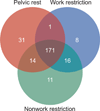Activity restriction among women with a short cervix
- PMID: 23812450
- PMCID: PMC4019312
- DOI: 10.1097/AOG.0b013e3182917529
Activity restriction among women with a short cervix
Abstract
Objective: To estimate determinants of and outcomes associated with activity restriction among women with a short cervix.
Methods: This was a secondary analysis of a randomized trial of 17-α hydroxyprogesterone caproate for prevention of preterm birth among nulliparous women with singleton gestations and cervices less than 30 mm by midtrimester ultrasonography. Women were asked weekly whether they had been placed on pelvic, work, or nonwork rest. "Any activity restriction" was defined as being placed on any type of rest. Factors associated with any activity restriction were determined and the association between preterm birth and activity restriction was estimated with multivariable logistic regression.
Results: Of the 657 women in the trial, 646 (98%) responded to questions regarding activity restriction. Two hundred fifty-two (39.0%) were placed on any activity restriction at a median of 23.9 weeks (interquartile range 22.6-27.9 weeks). Women on activity restriction were older, more likely to have private insurance, less likely to be Hispanic, had a shorter cervical length, and were more likely to have funneling and intra-amniotic debris. Preterm birth at less than 37 weeks of gestation was more common among women placed on activity restriction (37% compared with 17%, P<.001). After controlling for potential confounding factors, preterm birth remained more common among those placed on activity restriction (adjusted odds ratio 2.37, 95% confidence interval 1.60-3.53). Results were similar for preterm birth at less than 34 weeks of gestation.
Conclusion: Activity restriction did not reduce the rate of preterm birth in asymptomatic nulliparous women with a short cervix.
Conflict of interest statement
The authors did not report any potential conflicts of interest.
Figures
References
-
- Spong CY. Prediction and prevention of recurrent spontaneous preterm birth. Obstet Gynecol. 2007;110:405–415. - PubMed
-
- Goldenberg RL. The management of preterm labor. Obstet Gynecol. 2002;100:1020–1037. - PubMed
-
- Hobel CJ, Ross MG, Bemis RL, Bragonier JR, Nessim S, Sandhu M, et al. The West Los Angeles Preterm Birth Prevention Project. I. Program impact on high-risk women. Am J Obstet Gynecol. 1994;170:54–62. - PubMed
-
- Elliott JP, Miller HS, Coleman S, Rhea D, Abril D, Hallbauer K, et al. A randomized multicenter study to determine the efficacy of activity restriction for preterm labor management in patients testing negative for fetal fibronectin. J Perinatol. 2005;25:626–630. - PubMed
-
- Fox NS, Gelber SE, Kalish RB, Chasen ST. The recommendation for bed rest in the setting of arrested preterm labor and premature rupture of membranes. Am J Obstet Gynecol. 2009;200:165.e1–166.el. - PubMed
Publication types
MeSH terms
Grants and funding
- HD36801/HD/NICHD NIH HHS/United States
- UG1 HD027869/HD/NICHD NIH HHS/United States
- UG1 HD040560/HD/NICHD NIH HHS/United States
- UG1 HD027915/HD/NICHD NIH HHS/United States
- U10 HD040485/HD/NICHD NIH HHS/United States
- HD40485/HD/NICHD NIH HHS/United States
- HD40560/HD/NICHD NIH HHS/United States
- U10 HD040560/HD/NICHD NIH HHS/United States
- U10 HD053118/HD/NICHD NIH HHS/United States
- UL1 RR024989/RR/NCRR NIH HHS/United States
- UL1 TR000005/TR/NCATS NIH HHS/United States
- U10 HD040500/HD/NICHD NIH HHS/United States
- UL1 TR000150/TR/NCATS NIH HHS/United States
- U10 HD040544/HD/NICHD NIH HHS/United States
- UL1 RR024153/RR/NCRR NIH HHS/United States
- UL1 RR025764/RR/NCRR NIH HHS/United States
- UG1 HD034116/HD/NICHD NIH HHS/United States
- HD27869/HD/NICHD NIH HHS/United States
- HD53118/HD/NICHD NIH HHS/United States
- UG1 HD053097/HD/NICHD NIH HHS/United States
- HD40512/HD/NICHD NIH HHS/United States
- UG1 HD040544/HD/NICHD NIH HHS/United States
- UG1 HD034208/HD/NICHD NIH HHS/United States
- M01 RR00080/RR/NCRR NIH HHS/United States
- UG1 HD040512/HD/NICHD NIH HHS/United States
- HD40545/HD/NICHD NIH HHS/United States
- U10 HD034116/HD/NICHD NIH HHS/United States
- HD21410/HD/NICHD NIH HHS/United States
- U10 HD027869/HD/NICHD NIH HHS/United States
- U10 HD027917/HD/NICHD NIH HHS/United States
- HD34116/HD/NICHD NIH HHS/United States
- U10 HD027915/HD/NICHD NIH HHS/United States
- UG1 HD040545/HD/NICHD NIH HHS/United States
- UG1 HD040485/HD/NICHD NIH HHS/United States
- HD40500/HD/NICHD NIH HHS/United States
- U10 HD034208/HD/NICHD NIH HHS/United States
- U10 HD053097/HD/NICHD NIH HHS/United States
- HD34208/HD/NICHD NIH HHS/United States
- HD27915/HD/NICHD NIH HHS/United States
- UG1 HD040500/HD/NICHD NIH HHS/United States
- R24 HD050924/HD/NICHD NIH HHS/United States
- U10 HD040512/HD/NICHD NIH HHS/United States
- HD27917/HD/NICHD NIH HHS/United States
- U10 HD021410/HD/NICHD NIH HHS/United States
- M01 RR000080/RR/NCRR NIH HHS/United States
- U24 HD036801/HD/NICHD NIH HHS/United States
- U10 HD036801/HD/NICHD NIH HHS/United States
- HD53097/HD/NICHD NIH HHS/United States
- U10 HD040545/HD/NICHD NIH HHS/United States
- HD40544/HD/NICHD NIH HHS/United States
- U01 HD036801/HD/NICHD NIH HHS/United States
- 5UL1RR025764/RR/NCRR NIH HHS/United States
LinkOut - more resources
Full Text Sources
Other Literature Sources
Medical


